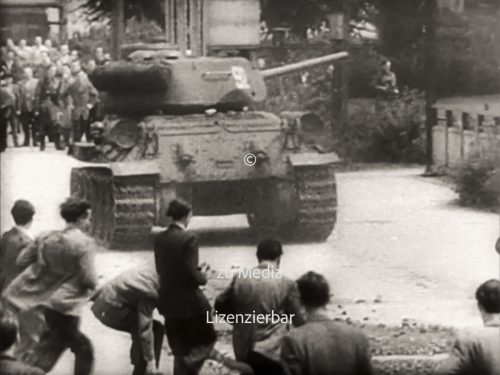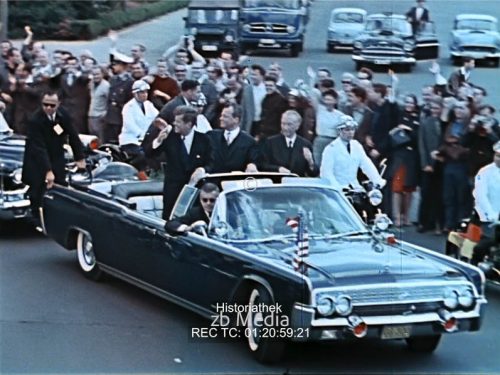The Soviet front 1941
Leningrad 1941; dead and tortured Russian civilians are found. The film footage shows pre-war Leningrad. 1941 Barricades are erected. The city is heavily bombed. 1941/1942; Leningrad (Soviet Union): Food is rationed. Shell production continues. (today St. Petersburg.) 1941/1942; Leningrad (Soviet Union): The city is under siege. Women clear rubble from the streets. The defences are manned. Food is rationed. The production of grenades continues. Supplies are brought across the frozen Lake Ladoga by lorry, tractor and railway. Winter snow covers the city. Nazi aeroplanes bomb lorries on the lake. A thaw sets in in spring. Children play in the sunshine. German prisoners enter the town. Reel 9 shows the battle for the Caucasus and the Crimea. Stalingrad is bombarded from the air with artillery and house-to-house fighting is shown. Reel 10 shows the Russian encirclement of the Nazis in Stalingrad. Marshal Nikolai Voronoff consults with his adjutants. The encircled Red armies meet in December 1942. Flamethrowers, rockets and artillery are used to force the remnants of 22 Nazi divisions to surrender. The final scene shows the Russian successes and statistics on the Nazi losses to date.
Historical Background
The Soviet Front in 1941 was a pivotal theater of World War II, marked by significant events and battles, primarily involving the German invasion of the Soviet Union, codenamed Operation Barbarossa.
Operation Barbarossa: Launched on June 22, 1941, by Nazi Germany, this invasion aimed to conquer the Soviet Union. The German forces, along with their Axis allies, launched a massive offensive along a 2,900-kilometer front, stretching from the Baltic Sea in the north to the Black Sea in the south.
Initial German Advances: The Germans made swift progress initially, exploiting the Soviet Union’s unpreparedness and disorganization. They encircled and captured large numbers of Soviet troops, and within weeks, they advanced deep into Soviet territory.
Battle of Smolensk: One of the early major battles, it lasted from July 10 to September 10, 1941. The Germans encircled and captured the city of Smolensk, inflicting heavy losses on the Soviet forces. However, the Soviet resistance slowed the German advance, delaying their timetable for capturing Moscow.
Siege of Leningrad: Leningrad (now Saint Petersburg) came under siege by German and Finnish forces in September 1941. The siege lasted for over 870 days and became one of the longest and most destructive sieges in history. The city endured severe hunger and suffering, but ultimately, it held out against the Germans.
Battle of Moscow: As the German advance towards Moscow slowed due to stiff Soviet resistance and the onset of winter, the Battle of Moscow began on October 2, 1941. It marked a turning point in the Eastern Front, as the Soviets launched a successful counteroffensive in December 1941, driving the Germans back and halting their advance towards Moscow.
Other Fronts: Alongside the main front, there were significant actions in other regions, such as the southern front, where the Germans advanced towards Ukraine and the Crimea, and the northern front, where Finnish forces, aligned with Germany, made advances into Soviet territory.
The year 1941 on the Eastern Front was characterized by intense fighting, massive casualties, and significant territorial changes as the Germans pushed deep into Soviet territory, but were ultimately halted and forced to retreat by the Soviet counteroffensives and the harsh winter conditions.





